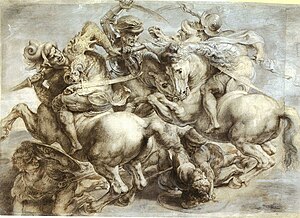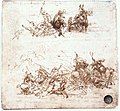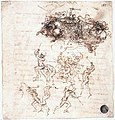
Leonardo di ser Piero da Vinci was an Italian polymath of the High Renaissance who was active as a painter, draughtsman, engineer, scientist, theorist, sculptor, and architect. While his fame initially rested on his achievements as a painter, he has also become known for his notebooks, in which he made drawings and notes on a variety of subjects, including anatomy, astronomy, botany, cartography, painting, and paleontology. Leonardo epitomized the Renaissance humanist ideal, and his collective works comprise a contribution to later generations of artists matched only by that of his younger contemporary Michelangelo.

Michelangelo di Lodovico Buonarroti Simoni, known mononymously as Michelangelo, was an Italian sculptor, painter, architect, and poet of the High Renaissance. Born in the Republic of Florence, his work was inspired by models from classical antiquity and had a lasting influence on Western art. Michelangelo's creative abilities and mastery in a range of artistic arenas define him as an archetypal Renaissance man, along with his rival and elder contemporary, Leonardo da Vinci. Given the sheer volume of surviving correspondence, sketches, and reminiscences, Michelangelo is one of the best-documented artists of the 16th century. He was lauded by contemporary biographers as the most accomplished artist of his era.

Giorgio Vasari was an Italian Renaissance painter and architect, who is best known for his work Lives of the Most Excellent Painters, Sculptors, and Architects, considered the ideological foundation of all art-historical writing, and still much cited in modern biographies of the many Italian Renaissance artists he covers, including Leonardo da Vinci and Michelangelo, although he is now regarded as including many factual errors, especially when covering artists from before he was born.
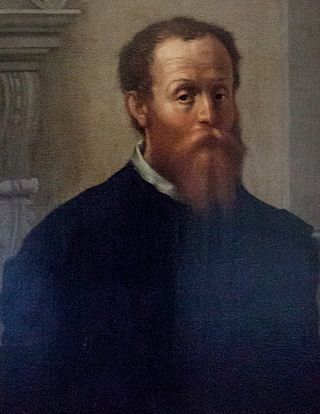
Baccio Bandinelli, was an Italian Renaissance sculptor, draughtsman, and painter.
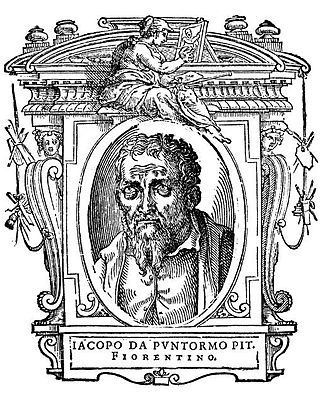
Jacopo Carucci or Carrucci, usually known as Jacopo (da) Pontormo or simply Pontormo, was an Italian Mannerist painter and portraitist from the Florentine School. His work represents a profound stylistic shift from the calm perspectival regularity that characterized the art of the Florentine Renaissance. He is famous for his use of twining poses, coupled with ambiguous perspective; his figures often seem to float in an uncertain environment, unhampered by the forces of gravity.

The Basilica di Santa Croce is a minor basilica and the principal Franciscan church of Florence, Italy. It is situated on the Piazza di Santa Croce, about 800 metres southeast of the Duomo, on what was once marshland beyond the city walls. Being the burial place of some of the most notable Italians, such as Michelangelo, Galileo, Machiavelli, the poet Foscolo, the philosopher Gentile and the composer Rossini, it is also known as the Temple of the Italian Glories.

The Palazzo Vecchio is the town hall of Florence, Italy. It overlooks the Piazza della Signoria, which holds a copy of Michelangelo's David statue, and the gallery of statues in the adjacent Loggia dei Lanzi.

Foiano della Chiana is a small agricultural town in eastern Tuscany, in the province of Arezzo, between the cities of Sinalunga and Cortona. It is well known for its annual carnival.
Medusa is either of two paintings described in Giorgio Vasari's Life of Leonardo da Vinci as being among Leonardo's earliest works. Neither painting survived.

Maurizio Seracini is a self-proclaimed diagnostician of Italian art.

Michele Tosini, also called Michele di Ridolfo, (1503–1577) was an Italian painter of the Renaissance and Mannerist period, who worked in Florence.

Florentine painting or the Florentine School refers to artists in, from, or influenced by the naturalistic style developed in Florence in the 14th century, largely through the efforts of Giotto di Bondone, and in the 15th century the leading school of Western painting. Some of the best known painters of the earlier Florentine School are Fra Angelico, Botticelli, Filippo Lippi, the Ghirlandaio family, Masolino, and Masaccio.

Italian Renaissance painting is the painting of the period beginning in the late 13th century and flourishing from the early 15th to late 16th centuries, occurring in the Italian Peninsula, which was at that time divided into many political states, some independent but others controlled by external powers. The painters of Renaissance Italy, although often attached to particular courts and with loyalties to particular towns, nonetheless wandered the length and breadth of Italy, often occupying a diplomatic status and disseminating artistic and philosophical ideas.

Pierino da Vinci, born Pier Francesco di Bartolomeo di Ser Piero da Vinci, was an Italian sculptor, born in the small town of Vinci in Tuscany; he was the nephew of Leonardo da Vinci.

The Battle of Cascina is a never-completed painting in fresco commissioned from Michelangelo for the Palazzo Vecchio in Florence. He created only the preparatory drawing before being called to Rome by Pope Julius II, where he worked on the Pope's tomb; before completing this project, he returned to Florence for some months to complete the cartoon.

The Battle of Cascina was an engagement between Pisan and Florentine troops on 28 July 1364 near Cascina, modern-day Italy. Florence's victory followed a recent defeat to Pisan forces that had enabled mercenary John Hawkwood, who was in command of the Pisan army, to occupy the Valdinievole, Prato en route to Florence. Hawkwood and his army looted the lucrative Mugello region and Pistoia before proceeding towards Florence. Hawkwood fought alongside Hanneken von Baumgarten and had 3,000 men-at-arms at his disposal.

Andrea del Sarto was an Italian painter from Florence, whose career flourished during the High Renaissance and early Mannerism. He was known as an outstanding fresco decorator, painter of altar-pieces, portraitist, draughtsman, and colorist. Although highly regarded during his lifetime as an artist senza errori, his renown was eclipsed after his death by that of his contemporaries Leonardo da Vinci, Michelangelo, and Raphael.
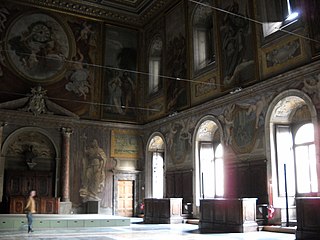
The Sala dei Cento Giorni is the largest reception room, the Salone d'Onore on the piano nobile, of the Palazzo della Cancelleria or Chancellery in Central Rome, Italy. The frescoes by Giorgio Vasari and his studio in 1547, epitomize the Mannerist style. Supposedly they were completed in a hundred days.
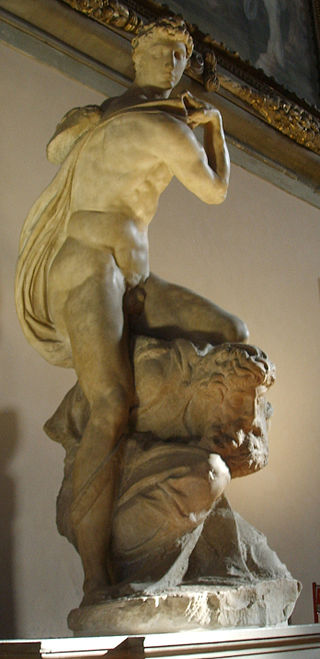
The Genius of Victory is a 1532–1534 marble sculpture by Michelangelo, produced as part of a design for the tomb of Pope Julius II. It is 2.61 m high and is now in the Salone dei Cinquecento of the Palazzo Vecchio in Florence.

Bathers at San Niccolò is a large oil painting by Domenico Cresti, known as Domenico Passignano, signed and dated 1600. The Mannerist painting depicts men bathing in the River Arno near the crenelated Tower of San Niccolò in Florence.
